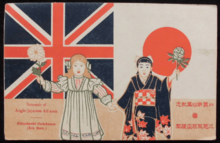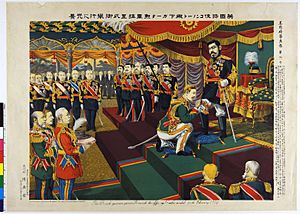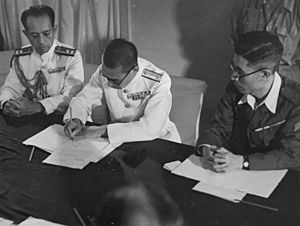Anglo-Japanese Alliance facts for kids
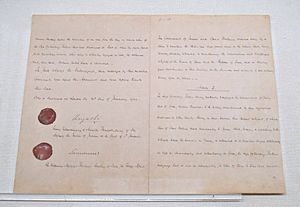
Anglo-Japanese Alliance, 30 January 1902. Diplomatic Archives of the Ministry of Foreign Affairs of Japan
|
|
| Type | Military alliance |
|---|---|
| Context | Mutual defense in the event of open war with another nation |
| Signed | 30 January 1902 |
| Location | London, England, United Kingdom |
| Effective | 31 January 1902 |
| Expiration | 1923 |
| Original signatories |
|
| Parties | |
| Languages | |
The Anglo-Japanese Alliance (also known as the Nichi-Ei Dōmei in Japanese) was an important agreement between Britain and Japan. It lasted from 1902 to 1922. Britain wanted to stop Russia from expanding its power in Asia. They also wanted to protect China and Korea.
For Britain, this alliance meant the end of "splendid isolation". This was a time when Britain avoided making alliances with other countries. The alliance allowed Britain to focus on protecting India and competing with Germany's navy. Japan gained respect from other countries because of this alliance. It also helped Japan with its foreign policy for twenty years.
The alliance was signed in London on January 30, 1902. It was signed by Lord Lansdowne, who was Britain's Foreign Secretary. Hayashi Tadasu, a Japanese diplomat, also signed it. The alliance was updated and made stronger twice, in 1905 and 1911. It played a big part in World War I. The alliance officially ended in 1923.
The biggest concern for both Britain and Japan was the growing power of Russia. France was allied with Russia but didn't want to fight Britain. So, France stayed neutral during the Russo-Japanese War in 1904. However, Britain's support for Japan made the United States and some British colonies unhappy. Their opinion of Japan became less friendly over time.
Contents
Why the Alliance Happened
Britain and Japan had thought about an alliance since 1895. This was when Britain didn't join other countries against Japan's control of the Liaodong Peninsula. Britain had also helped Japan modernize its country. Both nations worked together during the Boxer Rebellion in China. Newspapers in both countries supported the idea of an alliance.
A big reason for the alliance was to stop Russia from expanding. Russia had invaded Manchuria after the Boxer Rebellion. British diplomat Cecil Spring Rice believed that only Britain and Japan together could challenge Russia in Asia. Talks for the alliance began when Russia started moving into China.
However, both countries had some worries. Britain was careful about ending its "splendid isolation" policy. They didn't want to upset Russia. They also didn't want to act on the treaty if Japan attacked the United States. Some Japanese leaders, like Hirobumi Itō, hoped for a deal with Russia instead. They thought being friends with other Asian countries would be better for relations with the US. Also, Britain didn't want to protect Japan's interests in Korea. Japan didn't want to help Britain in India.
Discussions began in July 1901. They were delayed because of disagreements about Korea and India. In 1902, the alliance was quickly signed. It was the first time Britain made a military alliance during peacetime. It was also the first alliance between an Eastern and Western power on equal terms. This alliance led to other agreements for Britain, like the Entente Cordiale with France in 1904.
What the 1902 Treaty Said
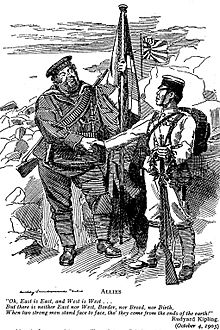
The treaty had six main points:
- Article 1: Both sides agreed to respect the independence of China and Korea. They said they had no plans to attack these countries. However, Britain had special interests in China. Japan had special interests in Korea, both politically and economically. If these interests were threatened, either country could take action to protect them. This included protecting their citizens and property.
- Article 2: If one country went to war because of Article 1, the other country would stay neutral.
- Article 3: If one country went to war with more than one other country, the other ally would provide support.
- Article 4: Neither country would make separate deals with other powers that would harm this alliance.
- Article 5: Both countries promised to talk openly and honestly if their interests were in danger.
- Article 6: The treaty would last for five years. After that, it could be ended with one year's notice.
Articles 2 and 3 were the most important for war and mutual defense. The treaty recognized Japan's interests in Korea. But Britain didn't have to help if Japan only fought one enemy. Japan also didn't have to defend British interests in India unless there were two enemies.
Both sides understood the treaty a bit differently. Britain saw it as a gentle warning to Russia. Japan felt stronger because of it. This made Japan less willing to compromise on Korea. Some even saw it as a chance for Japan to expand its empire.
Updates in 1905 and 1911
The alliance was updated in 1905. This happened partly because Japan had won the Russo-Japanese War. It also happened because Britain was worried about Japan's plans in South Asia. Japan seemed to support Indian independence movements. Britain also thought about asking Japan to help defend India.
The new agreement in July 1905 allowed Japan to support British interests in India. It also allowed Britain to support Japan's actions in Korea. By November 1905, Korea became a Japanese protectorate. In 1911, the alliance was renewed again. Japanese diplomat Komura Jutarō helped Japan regain control over its tariffs (taxes on imports).
The "second" alliance in 1905 was supposed to last ten years. But it was renewed early in 1911. The world's politics had changed a lot in those six years. Britain and Russia had settled their differences in 1907. Japan had also made agreements with Russia after the Russo-Japanese War. Britain and the US were becoming closer. Also, Britain's rivalry with Germany was growing. Because of these changes, Japan and Britain updated their alliance again.
What Happened Because of the Alliance
New Alliances and Rivalries
The first version of the alliance was announced on February 12, 1902. After this, Russia tried to form alliances with France and Germany. Germany refused. On March 16, 1902, France and Russia signed their own agreement. China and the United States were strongly against the Anglo-Japanese Alliance.
Role in the Russo-Japanese War
The Russo-Japanese War started in 1904. Japan wanted to stop Russia from expanding its colonies in China. Britain didn't officially join the war. However, Britain helped Japan with spying, ship design, money, and diplomacy. The Anglo-Japanese Alliance wasn't officially used because it only applied if a country fought more than one power. Japan was only fighting Russia. Because of the alliance, France couldn't help Russia without going to war with Britain. This was Britain's diplomatic help for Japan.
British and Japanese intelligence worked together against Russia even before the war. During the war, British military stations in Malaya and China intercepted Russian messages. They shared this information with Japan. Japan also shared information about Russia with Britain. British officials said Japanese intelligence was "perfect quality." Both countries gathered evidence that Germany was helping Russia. This made Britain see Germany as a growing threat.
World War I
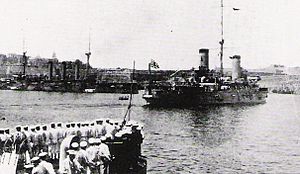
The alliance allowed Japan to join World War I on Britain's side. Japan was able to take over German lands in the Pacific north of the equator. Japan attacked the German base at Qingdao in 1914 and made the Germans surrender. Japanese officers on British warships were involved in the Battle of Jutland in 1916. In 1917, Japanese warships went to the Mediterranean. They helped protect Allied ships from German U-boat attacks. A memorial in Malta honors the 72 Japanese sailors who died, including those from the torpedoed Japanese destroyer Sakaki.
Cultural Connections
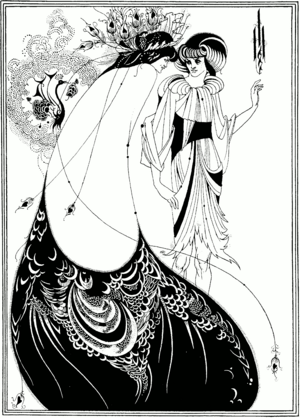
The alliance also led to good trade and cultural exchanges between Britain and Japan. Japanese companies published many English-language books and articles. Japan's fast growth in industry and military created new chances for British shipyards and arms makers to sell their goods. Japanese people who studied in Britain brought new technology back to Japan.
British artists like James McNeill Whistler and Aubrey Beardsley were inspired by Japanese art. They liked Japanese kimono, swords, and architecture.
A special cultural exchange involved Yoshimoto Tadasu. He was the first blind person in Japan to get a higher education. He wrote a book called True Britain in 1902. He brought British ideas about public welfare to Japan.
The Japan–British Exhibition in 1910 in London had eight million visitors. It showed how modern Japan had become. It also promoted the idea of a "people's alliance" between Britain and Japan. The exhibition featured Japanese art, music, and Sumo wrestling. It also showed Japanese "villages." The organizers presented Britain and Japan as similar "Island Empires." This was one of the biggest exhibitions of its time.
Challenges of the Alliance
Even though Britain and Japan were friendly, their relationship faced problems. One issue was the "Racial Equality Proposal" that Japan suggested at the Paris Peace Conference after World War I. Japan wanted a clause in the Covenant of the League of Nations that said all races were equal. Britain agreed with the idea of equality for all people in its empire. However, some British colonies, especially Australia, strongly opposed this. So, Britain decided not to support the clause.
Another problem was the Twenty-One Demands that Japan made to China in 1915. These demands would have given Japan a lot of control over China. China asked Britain and the US for help. They forced Japan to make its demands less harsh. Japan didn't gain much control in China, but it lost respect from Western countries, including Britain. Britain no longer fully trusted Japan as an ally.
Despite being a wealthy industrial power, Britain didn't invest much in Japan. British banks saw Japan as a risky investment. They offered loans with high interest rates, similar to those given to less developed countries. This disappointed Japan. However, Britain did lend money to Japan during the Russo-Japanese War. Japan also lent money to the Allies during World War I.
How the Treaty Ended
The alliance started to be seen as a problem at the Paris Peace Conference in 1919–1920. In July 1920, both governments said the alliance didn't quite fit with the new League of Nations rules.
The end of the alliance was discussed at the 1921 Imperial Conference. British and colonial leaders met to decide their international policy. Most leaders wanted to renew the alliance with Japan. They hoped it would protect British interests in the Pacific. Australia feared attacks from the Imperial Japanese Navy and wanted the alliance to continue.
However, Canadian Prime Minister Arthur Meighen worried about a war between Japan and the United States. He wanted Britain to leave the treaty to avoid being forced into such a war. The other leaders agreed it was best to get along with America. The American government feared that renewing the alliance would give Japan too much control in the Pacific. They worried it would block American trade with China. News media in America and Canada also reported false secret clauses against America in the treaty.
Because of the press and Meighen's arguments, the Imperial Conference decided to put the alliance aside. They told the League of Nations they wanted to consider leaving the alliance. The League said the alliance would continue unless one side gave a year's notice.
The British Empire chose to end its alliance with Japan to improve relations with the United States. They also wanted to stop Japan from forming an alliance with Germany or Russia. The British leaders convinced America to invite several nations to Washington for talks about the Pacific and naval disarmament. Japan came to the Washington Naval Conference feeling distrustful of Britain.
At the conference, the United States, Japan, France, and Britain signed the Four-Power Treaty. Other countries, including China, signed the Nine-Power Treaty. The Four-Power Treaty set out basic rules for international relations in the Pacific. It was a loose alliance without military commitments. The Four-Power Treaty made the Anglo-Japanese Alliance no longer active in December 1921. However, it didn't officially end until all countries approved the treaty on August 17, 1923.
Many experts believe that the distrust between Britain and Japan, and how the alliance ended, contributed to Japan's involvement in World War II.
See also
- Military alliance
- List of military alliances
- Anglo-German naval arms race
- Anglo-Japanese Treaty of Commerce and Navigation
- Eight-Nation Alliance
- History of Japanese foreign relations
- Japan–Korea Treaty of 1905
- Japan–United Kingdom relations
- Japanese entry into World War I
- Japan during World War I
- Root–Takahira Agreement
- Open Door Policy
- Treaty of Portsmouth
Images for kids



